|
SNAP Library 2.0, Developer Reference
2013-05-13 16:33:57
SNAP, a general purpose, high performance system for analysis and manipulation of large networks
|
|
SNAP Library 2.0, Developer Reference
2013-05-13 16:33:57
SNAP, a general purpose, high performance system for analysis and manipulation of large networks
|
Directed multigraph. More...
#include <graph.h>
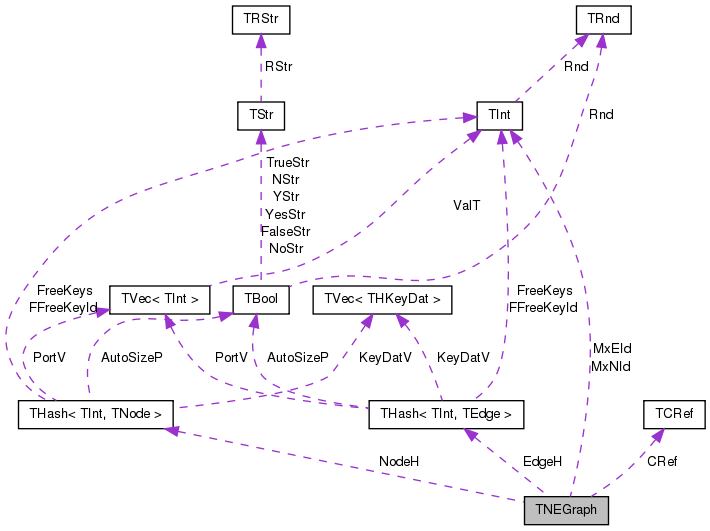
Classes | |
| class | TEdge |
| class | TEdgeI |
| Edge iterator. Only forward iteration (operator++) is supported. More... | |
| class | TNode |
| class | TNodeI |
| Node iterator. Only forward iteration (operator++) is supported. More... | |
Public Types | |
| typedef TNEGraph | TNet |
| typedef TPt< TNEGraph > | PNet |
Public Member Functions | |
| TNEGraph () | |
| TNEGraph (const int &Nodes, const int &Edges) | |
| Constructor that reserves enough memory for a graph of Nodes nodes and Edges edges. | |
| TNEGraph (const TNEGraph &Graph) | |
| TNEGraph (TSIn &SIn) | |
| Constructor for loading the graph from a (binary) stream SIn. | |
| void | Save (TSOut &SOut) const |
| Saves the graph to a (binary) stream SOut. | |
| bool | HasFlag (const TGraphFlag &Flag) const |
| Allows for run-time checking the type of the graph (see the TGraphFlag for flags). | |
| TNEGraph & | operator= (const TNEGraph &Graph) |
| int | GetNodes () const |
| Returns the number of nodes in the graph. | |
| int | AddNode (int NId=-1) |
| Adds a node of ID NId to the graph. | |
| int | AddNode (const TNodeI &NodeId) |
| Adds a node of ID NodeI.GetId() to the graph. | |
| void | DelNode (const int &NId) |
| Deletes node of ID NId from the graph. | |
| void | DelNode (const TNode &NodeI) |
| Deletes node of ID NodeI.GetId() from the graph. | |
| bool | IsNode (const int &NId) const |
| Tests whether ID NId is a node. | |
| TNodeI | BegNI () const |
| Returns an iterator referring to the first node in the graph. | |
| TNodeI | EndNI () const |
| Returns an iterator referring to the past-the-end node in the graph. | |
| TNodeI | GetNI (const int &NId) const |
| Returns an iterator referring to the node of ID NId in the graph. | |
| int | GetMxNId () const |
| Returns the maximum id of a any node in the graph. | |
| int | GetEdges () const |
| Returns the number of edges in the graph. | |
| int | AddEdge (const int &SrcNId, const int &DstNId, int EId=-1) |
| Adds an edge with ID EId between node IDs SrcNId and DstNId to the graph. | |
| int | AddEdge (const TEdgeI &EdgeI) |
| Adds an edge between EdgeI.GetSrcNId() and EdgeI.GetDstNId() to the graph. | |
| void | DelEdge (const int &EId) |
| Deletes an edge with edge ID EId from the graph. | |
| void | DelEdge (const int &SrcNId, const int &DstNId, const bool &IsDir=true) |
| Deletes all edges between node IDs SrcNId and DstNId from the graph. | |
| bool | IsEdge (const int &EId) const |
| Tests whether an edge with edge ID EId exists in the graph. | |
| bool | IsEdge (const int &SrcNId, const int &DstNId, const bool &IsDir=true) const |
| Tests whether an edge between node IDs SrcNId and DstNId exists in the graph. | |
| bool | IsEdge (const int &SrcNId, const int &DstNId, int &EId, const bool &IsDir=true) const |
| Tests whether an edge between node IDs SrcNId and DstNId exists in the graph. if an edge exists, return its edge ID in EId. | |
| int | GetEId (const int &SrcNId, const int &DstNId) const |
| Returns an edge ID between node IDs SrcNId and DstNId, if such an edge exists. Otherwise, return -1. | |
| TEdgeI | BegEI () const |
| Returns an iterator referring to the first edge in the graph. | |
| TEdgeI | EndEI () const |
| Returns an iterator referring to the past-the-end edge in the graph. | |
| TEdgeI | GetEI (const int &EId) const |
| TEdgeI | GetEI (const int &SrcNId, const int &DstNId) const |
| int | GetRndNId (TRnd &Rnd=TInt::Rnd) |
| Returns an ID of a random node in the graph. | |
| TNodeI | GetRndNI (TRnd &Rnd=TInt::Rnd) |
| Returns an interator referring to a random node in the graph. | |
| int | GetRndEId (TRnd &Rnd=TInt::Rnd) |
| Returns an ID of a random edge in the graph. | |
| TEdgeI | GetRndEI (TRnd &Rnd=TInt::Rnd) |
| Returns an interator referring to a random edge in the graph. | |
| void | GetNIdV (TIntV &NIdV) const |
| Gets a vector IDs of all nodes in the graph. | |
| void | GetEIdV (TIntV &EIdV) const |
| Gets a vector IDs of all edges in the graph. | |
| bool | Empty () const |
| Tests whether the graph is empty (has zero nodes). | |
| void | Clr () |
| Deletes all nodes and edges from the graph. | |
| void | Reserve (const int &Nodes, const int &Edges) |
| Reserves memory for a graph of Nodes nodes and Edges edges. | |
| void | Defrag (const bool &OnlyNodeLinks=false) |
| Defragments the graph. | |
| bool | IsOk (const bool &ThrowExcept=true) const |
| Checks the graph data structure for internal consistency. | |
| void | Dump (FILE *OutF=stdout) const |
| Print the graph in a human readable form to an output stream OutF. | |
Static Public Member Functions | |
| static PNEGraph | New () |
| Static constructor that returns a pointer to the graph. Call: PNEGraph Graph = TNEGraph::New(). | |
| static PNEGraph | New (const int &Nodes, const int &Edges) |
| Static constructor that returns a pointer to the graph and reserves enough memory for Nodes nodes and Edges edges. | |
| static PNEGraph | Load (TSIn &SIn) |
| Static constructor that loads the graph from a stream SIn and returns a pointer to it. | |
| static PNEGraph | GetSmallGraph () |
Private Member Functions | |
| TNode & | GetNode (const int &NId) |
| const TNode & | GetNode (const int &NId) const |
| TEdge & | GetEdge (const int &EId) |
| const TEdge & | GetEdge (const int &EId) const |
Private Attributes | |
| TCRef | CRef |
| TInt | MxNId |
| TInt | MxEId |
| THash< TInt, TNode > | NodeH |
| THash< TInt, TEdge > | EdgeH |
Friends | |
| class | TPt< TNEGraph > |
Directed multigraph.
Node IDs can be arbitrary non-negative integers. Nodes and edges have no attributes/data associated with them. There can be more than one directed edge from one source node to a destination node. Self loops (one per node) are allowed as well as multiple (parallel) edges.
| typedef TPt<TNEGraph> TNEGraph::PNet |
| typedef TNEGraph TNEGraph::TNet |
| TNEGraph::TNEGraph | ( | ) | [inline] |
| TNEGraph::TNEGraph | ( | const int & | Nodes, |
| const int & | Edges | ||
| ) | [inline, explicit] |
| TNEGraph::TNEGraph | ( | const TNEGraph & | Graph | ) | [inline] |
| TNEGraph::TNEGraph | ( | TSIn & | SIn | ) | [inline] |
| int TNEGraph::AddEdge | ( | const int & | SrcNId, |
| const int & | DstNId, | ||
| int | EId = -1 |
||
| ) |
Adds an edge with ID EId between node IDs SrcNId and DstNId to the graph.
Returns the ID of the edge being added. If EId is -1, edge ID is automatically assigned. Aborts, if an edge with ID EId already exists. Aborts, if SrcNId or DstNId are not nodes in the graph.
Definition at line 465 of file graph.cpp.
References THash< TKey, TDat, THashFunc >::AddDat(), TVec< TVal, TSizeTy >::AddSorted(), EdgeH, TStr::Fmt(), GetNode(), IAssertR, TNEGraph::TNode::InEIdV, IsEdge(), IsNode(), TMath::Mx(), MxEId, and TNEGraph::TNode::OutEIdV.
{
if (EId == -1) { EId = MxEId; MxEId++; }
else { MxEId = TMath::Mx(EId+1, MxEId()); }
IAssertR(!IsEdge(EId), TStr::Fmt("EdgeId %d already exists", EId));
IAssertR(IsNode(SrcNId) && IsNode(DstNId), TStr::Fmt("%d or %d not a node.", SrcNId, DstNId).CStr());
EdgeH.AddDat(EId, TEdge(EId, SrcNId, DstNId));
GetNode(SrcNId).OutEIdV.AddSorted(EId);
GetNode(DstNId).InEIdV.AddSorted(EId);
return EId;
}
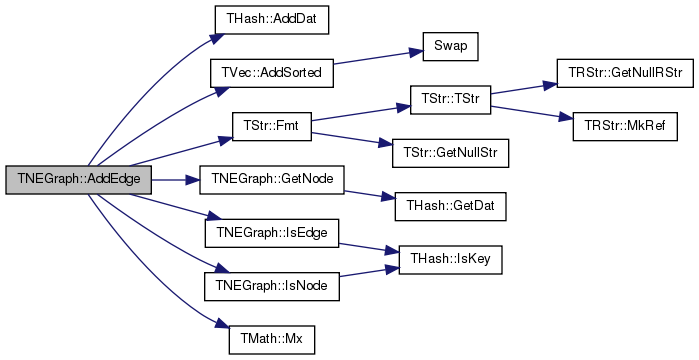
| int TNEGraph::AddEdge | ( | const TEdgeI & | EdgeI | ) | [inline] |
Adds an edge between EdgeI.GetSrcNId() and EdgeI.GetDstNId() to the graph.
Definition at line 746 of file graph.h.
References AddEdge(), TNEGraph::TEdgeI::GetDstNId(), TNEGraph::TEdgeI::GetId(), and TNEGraph::TEdgeI::GetSrcNId().
Referenced by AddEdge().
{ return AddEdge(EdgeI.GetSrcNId(), EdgeI.GetDstNId(), EdgeI.GetId()); }
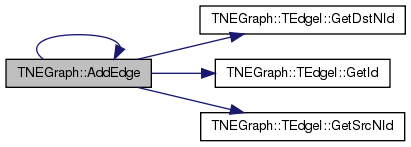

| int TNEGraph::AddNode | ( | int | NId = -1 | ) |
Adds a node of ID NId to the graph.
Returns the ID of the node being added. If NId is -1, node ID is automatically assigned. Aborts, if a node with ID NId already exists.
Definition at line 435 of file graph.cpp.
References THash< TKey, TDat, THashFunc >::AddDat(), TStr::Fmt(), IAssertR, IsNode(), TMath::Mx(), MxNId, and NodeH.
{
if (NId == -1) {
NId = MxNId; MxNId++;
} else {
IAssertR(!IsNode(NId), TStr::Fmt("NodeId %d already exists", NId));
MxNId = TMath::Mx(NId+1, MxNId());
}
NodeH.AddDat(NId, TNode(NId));
return NId;
}

| int TNEGraph::AddNode | ( | const TNodeI & | NodeId | ) | [inline] |
| TEdgeI TNEGraph::BegEI | ( | ) | const [inline] |
Returns an iterator referring to the first edge in the graph.
Definition at line 764 of file graph.h.
References THash< TKey, TDat, THashFunc >::BegI(), and EdgeH.
Referenced by Dump().


| TNodeI TNEGraph::BegNI | ( | ) | const [inline] |
Returns an iterator referring to the first node in the graph.
Definition at line 728 of file graph.h.
References THash< TKey, TDat, THashFunc >::BegI(), and NodeH.
Referenced by Dump().


| void TNEGraph::Clr | ( | ) | [inline] |
| void TNEGraph::Defrag | ( | const bool & | OnlyNodeLinks = false | ) |
Defragments the graph.
After performing many node and edge insertions and deletions to a graph, the graph data structure will be fragmented in memory. This function compacts down the graph data structure and frees unneeded memory.
Definition at line 526 of file graph.cpp.
References THash< TKey, TDat, THashFunc >::Defrag(), EdgeH, THash< TKey, TDat, THashFunc >::FFirstKeyId(), THash< TKey, TDat, THashFunc >::FNextKeyId(), TNEGraph::TNode::InEIdV, THash< TKey, TDat, THashFunc >::IsKeyIdEqKeyN(), NodeH, TNEGraph::TNode::OutEIdV, and TVec< TVal, TSizeTy >::Pack().
{
for (int kid = NodeH.FFirstKeyId(); NodeH.FNextKeyId(kid); ) {
TNode& Node = NodeH[kid];
Node.InEIdV.Pack(); Node.OutEIdV.Pack();
}
if (! OnlyNodeLinks && ! NodeH.IsKeyIdEqKeyN()) { NodeH.Defrag(); }
if (! OnlyNodeLinks && ! EdgeH.IsKeyIdEqKeyN()) { EdgeH.Defrag(); }
}
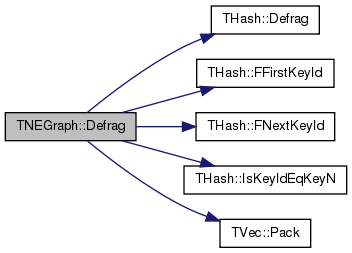
| void TNEGraph::DelEdge | ( | const int & | EId | ) |
Deletes an edge with edge ID EId from the graph.
Definition at line 476 of file graph.cpp.
References TVec< TVal, TSizeTy >::DelIfIn(), THash< TKey, TDat, THashFunc >::DelKey(), EdgeH, TNEGraph::TEdge::GetDstNId(), GetEdge(), GetNode(), TNEGraph::TEdge::GetSrcNId(), IAssert, TNEGraph::TNode::InEIdV, IsEdge(), and TNEGraph::TNode::OutEIdV.
{
IAssert(IsEdge(EId));
const int SrcNId = GetEdge(EId).GetSrcNId();
const int DstNId = GetEdge(EId).GetDstNId();
GetNode(SrcNId).OutEIdV.DelIfIn(EId);
GetNode(DstNId).InEIdV.DelIfIn(EId);
EdgeH.DelKey(EId);
}
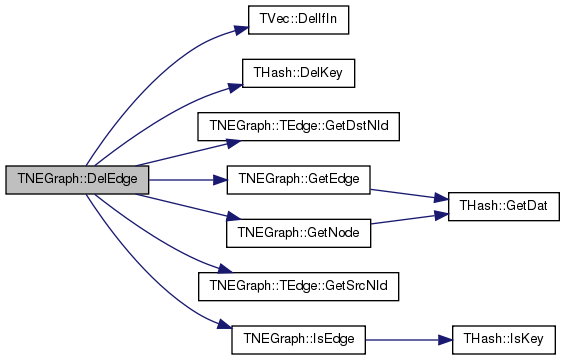
| void TNEGraph::DelEdge | ( | const int & | SrcNId, |
| const int & | DstNId, | ||
| const bool & | IsDir = true |
||
| ) |
Deletes all edges between node IDs SrcNId and DstNId from the graph.
If the edge (SrcNId, DstNId) does not exist in the graph function still completes. But the function aborts if SrcNId or DstNId are not nodes in the graph.
Definition at line 486 of file graph.cpp.
References TVec< TVal, TSizeTy >::DelIfIn(), THash< TKey, TDat, THashFunc >::DelKey(), EdgeH, GetNode(), IAssert, TNEGraph::TNode::InEIdV, IsEdge(), and TNEGraph::TNode::OutEIdV.
{
int EId;
IAssert(IsEdge(SrcNId, DstNId, EId, IsDir)); // there is at least one edge
while (IsEdge(SrcNId, DstNId, EId, IsDir)) {
GetNode(SrcNId).OutEIdV.DelIfIn(EId);
GetNode(DstNId).InEIdV.DelIfIn(EId);
}
EdgeH.DelKey(EId);
}
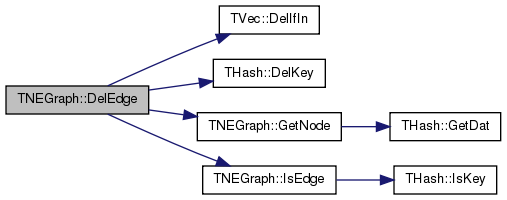
| void TNEGraph::DelNode | ( | const int & | NId | ) |
Deletes node of ID NId from the graph.
If the node of ID NId does not exist the function aborts.
Definition at line 446 of file graph.cpp.
References THash< TKey, TDat, THashFunc >::DelKey(), EdgeH, TNEGraph::TEdge::GetDstNId(), GetEdge(), TNEGraph::TNode::GetInDeg(), TNEGraph::TNode::GetInEId(), GetNode(), TNEGraph::TNode::GetOutDeg(), TNEGraph::TNode::GetOutEId(), TNEGraph::TEdge::GetSrcNId(), IAssert, and NodeH.
{
const TNode& Node = GetNode(NId);
for (int out = 0; out < Node.GetOutDeg(); out++) {
const int EId = Node.GetOutEId(out);
const TEdge& Edge = GetEdge(EId);
IAssert(Edge.GetSrcNId() == NId);
GetNode(Edge.GetDstNId()).InEIdV.DelIfIn(EId);
EdgeH.DelKey(EId);
}
for (int in = 0; in < Node.GetInDeg(); in++) {
const int EId = Node.GetInEId(in);
const TEdge& Edge = GetEdge(EId);
IAssert(Edge.GetDstNId() == NId);
GetNode(Edge.GetSrcNId()).OutEIdV.DelIfIn(EId);
EdgeH.DelKey(EId);
}
NodeH.DelKey(NId);
}
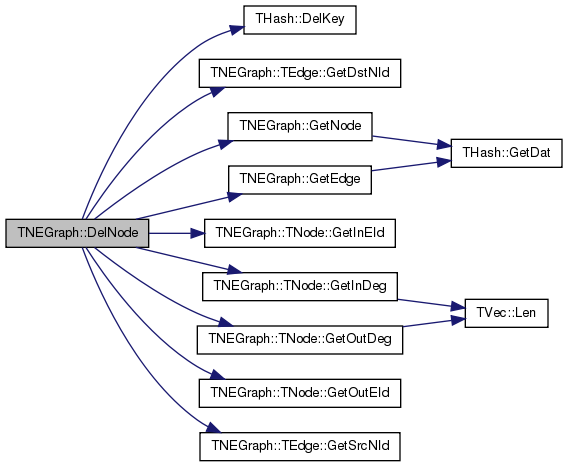
| void TNEGraph::DelNode | ( | const TNode & | NodeI | ) | [inline] |
| void TNEGraph::Dump | ( | FILE * | OutF = stdout | ) | const |
Print the graph in a human readable form to an output stream OutF.
Definition at line 588 of file graph.cpp.
References BegEI(), BegNI(), EndEI(), EndNI(), GetEdges(), and GetNodes().
{
const int NodePlaces = (int) ceil(log10((double) GetNodes()));
const int EdgePlaces = (int) ceil(log10((double) GetEdges()));
fprintf(OutF, "-------------------------------------------------\nDirected Node-Edge Graph: nodes: %d, edges: %d\n", GetNodes(), GetEdges());
for (TNodeI NodeI = BegNI(); NodeI < EndNI(); NodeI++) {
fprintf(OutF, " %*d]\n", NodePlaces, NodeI.GetId());
fprintf(OutF, " in[%d]", NodeI.GetInDeg());
for (int edge = 0; edge < NodeI.GetInDeg(); edge++) {
fprintf(OutF, " %*d", EdgePlaces, NodeI.GetInEId(edge)); }
fprintf(OutF, "\n out[%d]", NodeI.GetOutDeg());
for (int edge = 0; edge < NodeI.GetOutDeg(); edge++) {
fprintf(OutF, " %*d", EdgePlaces, NodeI.GetOutEId(edge)); }
fprintf(OutF, "\n");
}
for (TEdgeI EdgeI = BegEI(); EdgeI < EndEI(); EdgeI++) {
fprintf(OutF, " %*d] %*d -> %*d\n", EdgePlaces, EdgeI.GetId(), NodePlaces, EdgeI.GetSrcNId(), NodePlaces, EdgeI.GetDstNId());
}
fprintf(OutF, "\n");
}

| bool TNEGraph::Empty | ( | ) | const [inline] |
Tests whether the graph is empty (has zero nodes).
Definition at line 786 of file graph.h.
References GetNodes().
{ return GetNodes()==0; }

| TEdgeI TNEGraph::EndEI | ( | ) | const [inline] |
Returns an iterator referring to the past-the-end edge in the graph.
Definition at line 766 of file graph.h.
References EdgeH, and THash< TKey, TDat, THashFunc >::EndI().
Referenced by Dump().


| TNodeI TNEGraph::EndNI | ( | ) | const [inline] |
Returns an iterator referring to the past-the-end node in the graph.
Definition at line 730 of file graph.h.
References THash< TKey, TDat, THashFunc >::EndI(), and NodeH.
Referenced by Dump(), and TBPGraph::GetEI().


| TEdge& TNEGraph::GetEdge | ( | const int & | EId | ) | [inline, private] |
Definition at line 680 of file graph.h.
References EdgeH, and THash< TKey, TDat, THashFunc >::GetDat().
Referenced by DelEdge(), DelNode(), TNEGraph::TNodeI::GetInNId(), TNEGraph::TNodeI::GetNbrNId(), TNEGraph::TNodeI::GetOutNId(), IsEdge(), and TNEGraph::TNodeI::IsInNId().

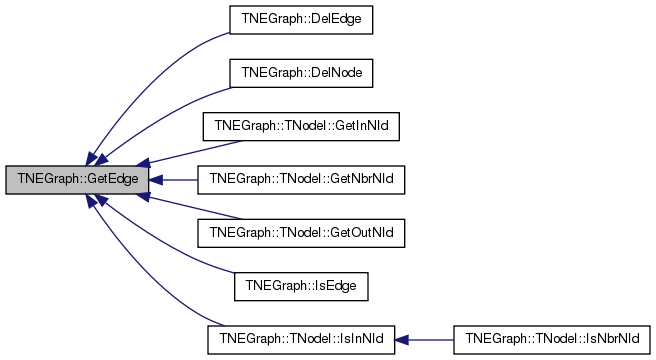
| const TEdge& TNEGraph::GetEdge | ( | const int & | EId | ) | const [inline, private] |
| int TNEGraph::GetEdges | ( | ) | const [inline] |
Returns the number of edges in the graph.
Definition at line 737 of file graph.h.
References EdgeH, and THash< TKey, TDat, THashFunc >::Len().
Referenced by Dump(), TBPGraph::Dump(), and GetEIdV().

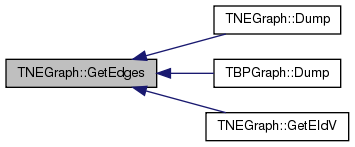
| TEdgeI TNEGraph::GetEI | ( | const int & | EId | ) | const [inline] |
Definition at line 768 of file graph.h.
References EdgeH, and THash< TKey, TDat, THashFunc >::GetI().
Referenced by GetRndEI().


| TEdgeI TNEGraph::GetEI | ( | const int & | SrcNId, |
| const int & | DstNId | ||
| ) | const [inline] |
| int TNEGraph::GetEId | ( | const int & | SrcNId, |
| const int & | DstNId | ||
| ) | const [inline] |
Returns an edge ID between node IDs SrcNId and DstNId, if such an edge exists. Otherwise, return -1.
Definition at line 762 of file graph.h.
References IsEdge().
Referenced by GetEI().
{ int EId; return IsEdge(SrcNId, DstNId, EId)?EId:-1; }


| void TNEGraph::GetEIdV | ( | TIntV & | EIdV | ) | const |
Gets a vector IDs of all edges in the graph.
Definition at line 519 of file graph.cpp.
References TVec< TVal, TSizeTy >::Add(), EdgeH, THash< TKey, TDat, THashFunc >::FFirstKeyId(), THash< TKey, TDat, THashFunc >::FNextKeyId(), TVec< TVal, TSizeTy >::Gen(), GetEdges(), and THash< TKey, TDat, THashFunc >::GetKey().
{
EIdV.Gen(GetEdges(), 0);
for (int E=EdgeH.FFirstKeyId(); EdgeH.FNextKeyId(E); ) {
EIdV.Add(EdgeH.GetKey(E));
}
}
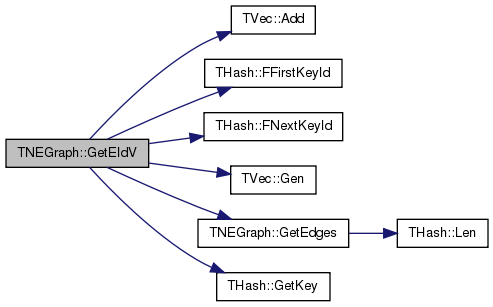
| int TNEGraph::GetMxNId | ( | ) | const [inline] |
| TNodeI TNEGraph::GetNI | ( | const int & | NId | ) | const [inline] |
Returns an iterator referring to the node of ID NId in the graph.
Definition at line 732 of file graph.h.
References THash< TKey, TDat, THashFunc >::GetI(), and NodeH.
Referenced by TBPGraph::GetEI(), and GetRndNI().


| void TNEGraph::GetNIdV | ( | TIntV & | NIdV | ) | const |
Gets a vector IDs of all nodes in the graph.
Definition at line 513 of file graph.cpp.
References TVec< TVal, TSizeTy >::Add(), THash< TKey, TDat, THashFunc >::FFirstKeyId(), THash< TKey, TDat, THashFunc >::FNextKeyId(), TVec< TVal, TSizeTy >::Gen(), THash< TKey, TDat, THashFunc >::GetKey(), GetNodes(), and NodeH.
{
NIdV.Gen(GetNodes(), 0);
for (int N=NodeH.FFirstKeyId(); NodeH.FNextKeyId(N); ) {
NIdV.Add(NodeH.GetKey(N)); }
}
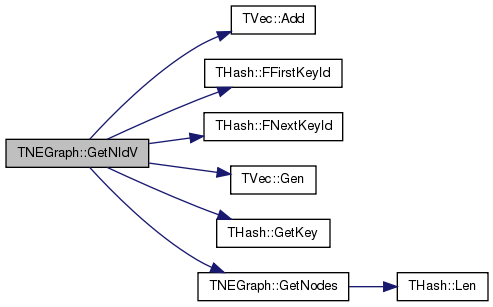
| TNode& TNEGraph::GetNode | ( | const int & | NId | ) | [inline, private] |
| const TNode& TNEGraph::GetNode | ( | const int & | NId | ) | const [inline, private] |
| int TNEGraph::GetNodes | ( | ) | const [inline] |
Returns the number of nodes in the graph.
Definition at line 710 of file graph.h.
References THash< TKey, TDat, THashFunc >::Len(), and NodeH.
Referenced by Dump(), TBPGraph::Dump(), Empty(), GetNIdV(), TBPGraph::GetNIdV(), and TBPGraph::GetRndNId().

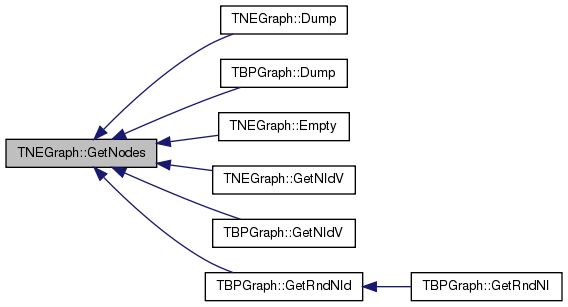
| TEdgeI TNEGraph::GetRndEI | ( | TRnd & | Rnd = TInt::Rnd | ) | [inline] |
| int TNEGraph::GetRndEId | ( | TRnd & | Rnd = TInt::Rnd | ) | [inline] |
Returns an ID of a random edge in the graph.
Definition at line 777 of file graph.h.
References EdgeH, THash< TKey, TDat, THashFunc >::GetKey(), and THash< TKey, TDat, THashFunc >::GetRndKeyId().
Referenced by GetRndEI().
{ return EdgeH.GetKey(EdgeH.GetRndKeyId(Rnd, 0.8)); }


| TNodeI TNEGraph::GetRndNI | ( | TRnd & | Rnd = TInt::Rnd | ) | [inline] |
| int TNEGraph::GetRndNId | ( | TRnd & | Rnd = TInt::Rnd | ) | [inline] |
Returns an ID of a random node in the graph.
Definition at line 773 of file graph.h.
References THash< TKey, TDat, THashFunc >::GetKey(), THash< TKey, TDat, THashFunc >::GetRndKeyId(), and NodeH.
Referenced by GetRndNI().
{ return NodeH.GetKey(NodeH.GetRndKeyId(Rnd, 0.8)); }


| static PNEGraph TNEGraph::GetSmallGraph | ( | ) | [static] |
| bool TNEGraph::HasFlag | ( | const TGraphFlag & | Flag | ) | const |
Allows for run-time checking the type of the graph (see the TGraphFlag for flags).
Definition at line 413 of file graph.cpp.
References HasGraphFlag.
{
return HasGraphFlag(TNEGraph::TNet, Flag);
}
| bool TNEGraph::IsEdge | ( | const int & | EId | ) | const [inline] |
Tests whether an edge with edge ID EId exists in the graph.
Definition at line 756 of file graph.h.
References EdgeH, and THash< TKey, TDat, THashFunc >::IsKey().
Referenced by AddEdge(), DelEdge(), GetEId(), and IsOk().

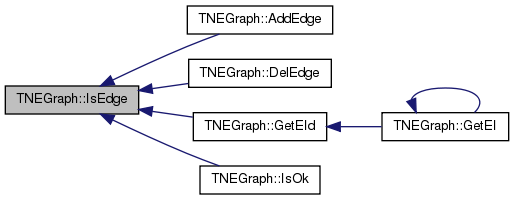
| bool TNEGraph::IsEdge | ( | const int & | SrcNId, |
| const int & | DstNId, | ||
| const bool & | IsDir = true |
||
| ) | const [inline] |
Tests whether an edge between node IDs SrcNId and DstNId exists in the graph.
Definition at line 758 of file graph.h.
References IsEdge().
Referenced by IsEdge().
{ int EId; return IsEdge(SrcNId, DstNId, EId, IsDir); }


| bool TNEGraph::IsEdge | ( | const int & | SrcNId, |
| const int & | DstNId, | ||
| int & | EId, | ||
| const bool & | IsDir = true |
||
| ) | const |
Tests whether an edge between node IDs SrcNId and DstNId exists in the graph. if an edge exists, return its edge ID in EId.
Definition at line 496 of file graph.cpp.
References TNEGraph::TEdge::GetDstNId(), GetEdge(), TNEGraph::TEdge::GetId(), TNEGraph::TNode::GetInDeg(), TNEGraph::TNode::GetInEId(), GetNode(), TNEGraph::TNode::GetOutDeg(), TNEGraph::TNode::GetOutEId(), and TNEGraph::TEdge::GetSrcNId().
{
const TNode& SrcNode = GetNode(SrcNId);
for (int edge = 0; edge < SrcNode.GetOutDeg(); edge++) {
const TEdge& Edge = GetEdge(SrcNode.GetOutEId(edge));
if (DstNId == Edge.GetDstNId()) {
EId = Edge.GetId(); return true; }
}
if (! IsDir) {
for (int edge = 0; edge < SrcNode.GetInDeg(); edge++) {
const TEdge& Edge = GetEdge(SrcNode.GetInEId(edge));
if (DstNId == Edge.GetSrcNId()) {
EId = Edge.GetId(); return true; }
}
}
return false;
}

| bool TNEGraph::IsNode | ( | const int & | NId | ) | const [inline] |
Tests whether ID NId is a node.
Definition at line 726 of file graph.h.
References THash< TKey, TDat, THashFunc >::IsKey(), and NodeH.
Referenced by AddEdge(), AddNode(), TBPGraph::DelNode(), TBPGraph::IsEdge(), and IsOk().

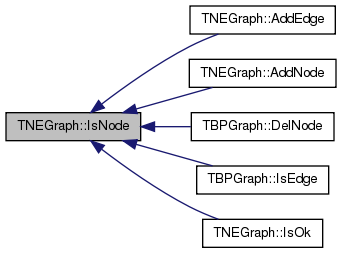
| bool TNEGraph::IsOk | ( | const bool & | ThrowExcept = true | ) | const |
Checks the graph data structure for internal consistency.
For each node in the graph check that its neighbors are also nodes in the graph.
Definition at line 535 of file graph.cpp.
References TStr::CStr(), EAssertR, EdgeH, ErrNotify(), THash< TKey, TDat, THashFunc >::FFirstKeyId(), TStr::Fmt(), THash< TKey, TDat, THashFunc >::FNextKeyId(), TNEGraph::TEdge::GetDstNId(), TNEGraph::TNode::GetId(), TNEGraph::TEdge::GetId(), TNEGraph::TNode::GetInDeg(), TNEGraph::TNode::GetInEId(), TNEGraph::TNode::GetOutDeg(), TNEGraph::TNode::GetOutEId(), TNEGraph::TEdge::GetSrcNId(), TNEGraph::TNode::InEIdV, IsEdge(), IsNode(), TVec< TVal, TSizeTy >::IsSorted(), NodeH, and TNEGraph::TNode::OutEIdV.
{
bool RetVal = true;
for (int N = NodeH.FFirstKeyId(); NodeH.FNextKeyId(N); ) {
const TNode& Node = NodeH[N];
if (! Node.OutEIdV.IsSorted()) {
const TStr Msg = TStr::Fmt("Out-edge list of node %d is not sorted.", Node.GetId());
if (ThrowExcept) { EAssertR(false, Msg); } else { ErrNotify(Msg.CStr()); } RetVal=false;
}
if (! Node.InEIdV.IsSorted()) {
const TStr Msg = TStr::Fmt("In-edge list of node %d is not sorted.", Node.GetId());
if (ThrowExcept) { EAssertR(false, Msg); } else { ErrNotify(Msg.CStr()); } RetVal=false;
}
// check out-edge ids
int prevEId = -1;
for (int e = 0; e < Node.GetOutDeg(); e++) {
if (! IsEdge(Node.GetOutEId(e))) {
const TStr Msg = TStr::Fmt("Out-edge id %d of node %d does not exist.", Node.GetOutEId(e), Node.GetId());
if (ThrowExcept) { EAssertR(false, Msg); } else { ErrNotify(Msg.CStr()); } RetVal=false;
}
if (e > 0 && prevEId == Node.GetOutEId(e)) {
const TStr Msg = TStr::Fmt("Node %d has duplidate out-edge id %d.", Node.GetId(), Node.GetOutEId(e));
if (ThrowExcept) { EAssertR(false, Msg); } else { ErrNotify(Msg.CStr()); } RetVal=false;
}
prevEId = Node.GetOutEId(e);
}
// check in-edge ids
prevEId = -1;
for (int e = 0; e < Node.GetInDeg(); e++) {
if (! IsEdge(Node.GetInEId(e))) {
const TStr Msg = TStr::Fmt("Out-edge id %d of node %d does not exist.", Node.GetInEId(e), Node.GetId());
if (ThrowExcept) { EAssertR(false, Msg); } else { ErrNotify(Msg.CStr()); } RetVal=false;
}
if (e > 0 && prevEId == Node.GetInEId(e)) {
const TStr Msg = TStr::Fmt("Node %d has duplidate out-edge id %d.", Node.GetId(), Node.GetInEId(e));
if (ThrowExcept) { EAssertR(false, Msg); } else { ErrNotify(Msg.CStr()); } RetVal=false;
}
prevEId = Node.GetInEId(e);
}
}
for (int E = EdgeH.FFirstKeyId(); EdgeH.FNextKeyId(E); ) {
const TEdge& Edge = EdgeH[E];
if (! IsNode(Edge.GetSrcNId())) {
const TStr Msg = TStr::Fmt("Edge %d source node %d does not exist.", Edge.GetId(), Edge.GetSrcNId());
if (ThrowExcept) { EAssertR(false, Msg); } else { ErrNotify(Msg.CStr()); } RetVal=false;
}
if (! IsNode(Edge.GetDstNId())) {
const TStr Msg = TStr::Fmt("Edge %d destination node %d does not exist.", Edge.GetId(), Edge.GetDstNId());
if (ThrowExcept) { EAssertR(false, Msg); } else { ErrNotify(Msg.CStr()); } RetVal=false;
}
}
return RetVal;
}
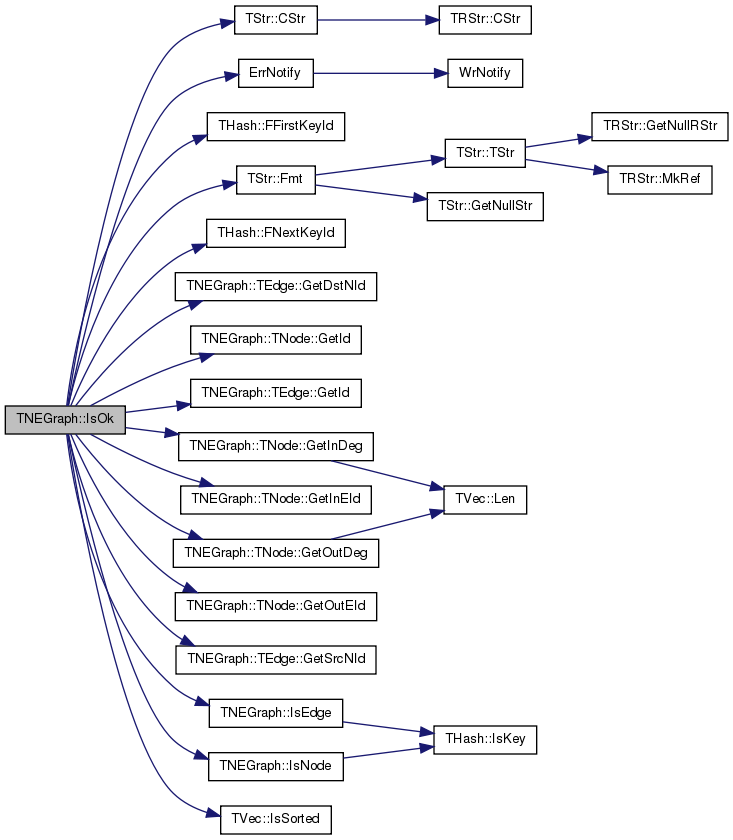
| static PNEGraph TNEGraph::Load | ( | TSIn & | SIn | ) | [inline, static] |
Static constructor that loads the graph from a stream SIn and returns a pointer to it.
Definition at line 703 of file graph.h.
References TNEGraph().

| static PNEGraph TNEGraph::New | ( | ) | [inline, static] |
Static constructor that returns a pointer to the graph. Call: PNEGraph Graph = TNEGraph::New().
Definition at line 697 of file graph.h.
References TNEGraph().
Referenced by TBPGraph::GetSmallGraph().


| static PNEGraph TNEGraph::New | ( | const int & | Nodes, |
| const int & | Edges | ||
| ) | [inline, static] |
Static constructor that returns a pointer to the graph and reserves enough memory for Nodes nodes and Edges edges.
Call: PNEGraph Graph = TNEGraph::New(Nodes, Edges).
Definition at line 701 of file graph.h.
References TNEGraph().

| void TNEGraph::Reserve | ( | const int & | Nodes, |
| const int & | Edges | ||
| ) | [inline] |
Reserves memory for a graph of Nodes nodes and Edges edges.
Definition at line 790 of file graph.h.
References EdgeH, THash< TKey, TDat, THashFunc >::Gen(), and NodeH.
Referenced by TNEGraph().


| void TNEGraph::Save | ( | TSOut & | SOut | ) | const [inline] |
TCRef TNEGraph::CRef [private] |
THash<TInt, TEdge> TNEGraph::EdgeH [private] |
TInt TNEGraph::MxEId [private] |
TInt TNEGraph::MxNId [private] |
Definition at line 684 of file graph.h.
Referenced by AddNode(), TBPGraph::AddNode(), Clr(), GetMxNId(), operator=(), and Save().
THash<TInt, TNode> TNEGraph::NodeH [private] |